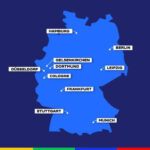The euro is the official currency for a significant portion of Europe, simplifying transactions and travel across numerous countries. Understanding where the euro is used is essential for travelers, businesses, and anyone interested in European economics. So, Euro Where Is It Used? Let’s explore the countries and territories that have adopted the euro.
The Eurozone: Countries Officially Using the Euro
The primary area where the euro is used is within the Eurozone. This consists of 20 member states of the European Union that have adopted the euro as their official currency. These countries are:
- Austria
- Belgium
- Croatia
- Cyprus
- Estonia
- Finland
- France
- Germany
- Greece
- Ireland
- Italy
- Latvia
- Lithuania
- Luxembourg
- Malta
- Netherlands
- Portugal
- Slovakia
- Slovenia
- Spain
In these nations, the euro is legal tender, and you can use euro banknotes and coins for all transactions. This makes traveling between these countries seamless in terms of currency exchange.
Euro Beyond the Eurozone: Territories and Special Cases
The reach of the euro extends beyond the 20 Eurozone countries. Several territories and non-EU states also utilize the euro, either officially or de facto.
European Territories: The euro is also used in several overseas territories of EU member states, including:
- Azores and Madeira (Portugal)
- Canary Islands, Ceuta and Melilla (Spain)
- French Guiana, Guadeloupe, Martinique, Mayotte, Réunion, Saint Barthélemy, and Saint Pierre and Miquelon (France)
Non-EU Countries with Agreements: Four non-EU countries have formal agreements with the EU allowing them to use the euro as their official currency:
- Andorra
- Monaco
- San Marino
- Vatican City
De Facto Adoption: Additionally, some countries and territories use the euro as their de facto currency without a formal agreement, such as Kosovo and Montenegro. In these locations, while not officially adopted, the euro is widely accepted for transactions.
Using Euro for Payments: Cash and Card
Within the EU and Eurozone, using the euro for payments is straightforward. EU legislation ensures that cross-border euro payments within the EU are charged the same as domestic payments. This applies to electronic payments, making card transactions convenient and cost-effective. This regulation also extends to euro transactions even in countries outside the Eurozone, meaning transfers and payments in euro are standardized across a broader region.
Conclusion
The euro is a widely used currency, not only in the official Eurozone but also in numerous territories and countries beyond. Understanding “euro where is it used” reveals its significant influence in Europe and its practicality for travel and international commerce within this region. Whether you are traveling to France, or conducting business with Germany, knowing the reach of the euro simplifies financial interactions across a large part of Europe.

